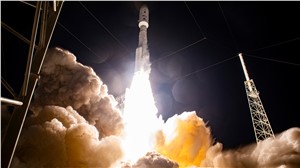NGC Makes Critical Contributions to STP-3 Mission for US Space Force
December 07, 2021
-Northrop Grumman Corporation technologies played a vital role in the U.S. Space Force’s Space Test Program (STP)-3 mission. Today, a United Launch Alliance (ULA) Atlas V rocket successfully launched the Northrop Grumman-built Space Test Program Satellite (STPSat)-6 and the Long Duration Propulsive Evolved Expendable Launch Vehicle (EELV) Secondary Payload Adapter (ESPA), known as LDPE-1, into orbit in support of STP-3. Northrop Grumman also provided critical components to the Atlas V rocket, continuing more than three decades of support to this program.
Built on Northrop Grumman’s highly successful LEOStar-3 platform, STPSat-6 is the primary spacecraft for the STP-3 mission. STP-3 supports advanced communications capabilities, the collection of space weather data and nuclear detonation detection in the Earth’s atmosphere or in near space. LDPE-1, launched along with STPSat-6, was built using Northrop Grumman’s ESPAStar bus. LDPE-1 hosts diverse payloads for the government and offers affordable ridesharing services to the Space Force.
“STPSat-6 and LDPE both provide flexible and cost-effective access to space while supporting critical technology development and operational payloads,” said Blake Bullock, vice president, national security systems, Northrop Grumman. “Northrop Grumman’s ESPAStar flexible, modular product line enables us to provide mission-critical solutions for today’s rapid-response space environment.”
STPSat-6 carries several payloads for the Department of Defense (DoD), National Nuclear Security Administration (NNSA) and NASA, which includes the Space and Atmospheric Burst Reporting System (SABRS-3), NASA’s Laser Communication Relay Demonstration (LCRD) and several experiments from the DoD Space Experiments Review Board.
Northrop Grumman also provides key elements in ULA’s Atlas V launch vehicle. The 63-inch-diameter Graphite Epoxy Motor (GEM 63) solid rocket motors were used on the ULA Atlas V for the first time since their inaugural flight in November 2020. Five strap-on boosters, manufactured at the company’s Magna, Utah, facility, were used in today’s launch, each contributing 371,500 pounds of maximum thrust. The company manufactured the Atlas V rocket’s reaction control system propellant tanks at its Commerce, California, facility, and eight retro motors at its Elkton, Maryland, facility that assist first and second stage separation.
Using advanced fiber placement manufacturing and automated inspection techniques, Northrop Grumman produced the composite heat shield that provides essential protection to the ULA Atlas V first stage engine, the Centaur Interstage Adapter that houses the second stage engine, and the broadtail that adapts from the core vehicle to the five-meter diameter fairing. Northrop Grumman fabricated these structures at its Iuka, Mississippi, facility.
Source : Northrop Grumman Corporation

Related Studies

Global Space Industry Market and Technology Forecast to 2026
Publish date: April 2018 - Pages: 233

Global Space Launch Systems - Market and Technology Forecast to 2027
Publish date: October 2019 - Pages: 305